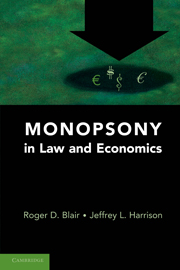Book contents
- Frontmatter
- Contents
- Preface
- ONE Introduction
- TWO The Antitrust Laws and Monopsonistic Forms of Conduct
- THREE Economic Theory of Monopsony
- FOUR The Antitrust Response to Monopsony and Collusive Monopsony
- FIVE Cooperative Buying Efforts
- SIX Bilateral Monopoly
- SEVEN Monopsony and Antitrust Enforcement
- EIGHT Monopsony in Action: Agricultural Markets
- NINE Monopsony in Action: The NCAA
- TEN Monopsony in Action: Physician Collective Bargaining: Monopoly or Bilateral Monopoly
- ELEVEN Final Comments
- Bibliography
- Index
- References
SEVEN - Monopsony and Antitrust Enforcement
Published online by Cambridge University Press: 05 June 2012
- Frontmatter
- Contents
- Preface
- ONE Introduction
- TWO The Antitrust Laws and Monopsonistic Forms of Conduct
- THREE Economic Theory of Monopsony
- FOUR The Antitrust Response to Monopsony and Collusive Monopsony
- FIVE Cooperative Buying Efforts
- SIX Bilateral Monopoly
- SEVEN Monopsony and Antitrust Enforcement
- EIGHT Monopsony in Action: Agricultural Markets
- NINE Monopsony in Action: The NCAA
- TEN Monopsony in Action: Physician Collective Bargaining: Monopoly or Bilateral Monopoly
- ELEVEN Final Comments
- Bibliography
- Index
- References
Summary
Introduction
The antitrust laws proscribe some business conduct that is in the individual self-interest of those with an opportunity to exercise market power as sellers or as buyers. One cannot expect the would-be monopolist or monopsonist to willingly surrender the potential profits that accompany the exercise of their market power. As a result, it is unlikely that enacting the antitrust laws would have accomplished much without an active enforcement effort and sanctions to go along with it. In this chapter, we turn our attention to antitrust enforcement and an analysis of the sanctions for antitrust violations.
Enforcement of the antitrust laws is divided among federal antitrust enforcement agencies, the attorneys general of the individual states, and private plaintiffs. The level of enforcement by these parties can vary significantly from year to year. Moreover, when public authorities are involved, it is possible for violators to incur criminal penalties. For example, presently the maximum corporate fine is $100 million, the maximum individual fine is $1 million, and the maximum prison sentence is ten years.
- Type
- Chapter
- Information
- Monopsony in Law and Economics , pp. 146 - 171Publisher: Cambridge University PressPrint publication year: 2010
References
- 7
- Cited by



